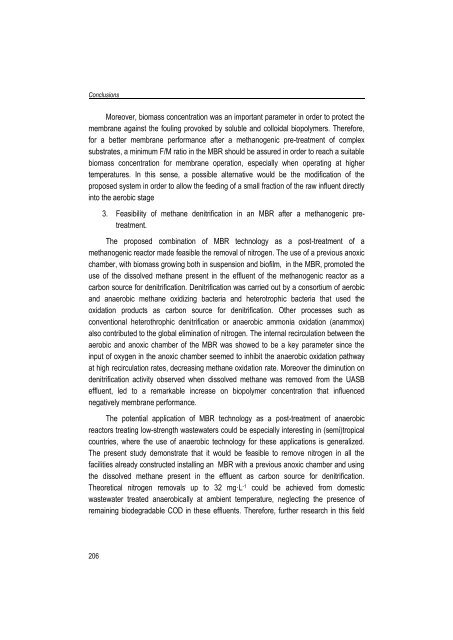Combining submerged membrane technology with anaerobic and ...
Combining submerged membrane technology with anaerobic and ...
Combining submerged membrane technology with anaerobic and ...
Create successful ePaper yourself
Turn your PDF publications into a flip-book with our unique Google optimized e-Paper software.
ConclusionsMoreover, biomass concentration was an important parameter in order to protect the<strong>membrane</strong> against the fouling provoked by soluble <strong>and</strong> colloidal biopolymers. Therefore,for a better <strong>membrane</strong> performance after a methanogenic pre-treatment of complexsubstrates, a minimum F/M ratio in the MBR should be assured in order to reach a suitablebiomass concentration for <strong>membrane</strong> operation, especially when operating at highertemperatures. In this sense, a possible alternative would be the modification of theproposed system in order to allow the feeding of a small fraction of the raw influent directlyinto the aerobic stage3. Feasibility of methane denitrification in an MBR after a methanogenic pretreatment.The proposed combination of MBR <strong>technology</strong> as a post-treatment of amethanogenic reactor made feasible the removal of nitrogen. The use of a previous anoxicchamber, <strong>with</strong> biomass growing both in suspension <strong>and</strong> biofilm, in the MBR, promoted theuse of the dissolved methane present in the effluent of the methanogenic reactor as acarbon source for denitrification. Denitrification was carried out by a consortium of aerobic<strong>and</strong> <strong>anaerobic</strong> methane oxidizing bacteria <strong>and</strong> heterotrophic bacteria that used theoxidation products as carbon source for denitrification. Other processes such asconventional heterothrophic denitrification or <strong>anaerobic</strong> ammonia oxidation (anammox)also contributed to the global elimination of nitrogen. The internal recirculation between theaerobic <strong>and</strong> anoxic chamber of the MBR was showed to be a key parameter since theinput of oxygen in the anoxic chamber seemed to inhibit the <strong>anaerobic</strong> oxidation pathwayat high recirculation rates, decreasing methane oxidation rate. Moreover the diminution ondenitrification activity observed when dissolved methane was removed from the UASBeffluent, led to a remarkable increase on biopolymer concentration that influencednegatively <strong>membrane</strong> performance.The potential application of MBR <strong>technology</strong> as a post-treatment of <strong>anaerobic</strong>reactors treating low-strength wastewaters could be especially interesting in (semi)tropicalcountries, where the use of <strong>anaerobic</strong> <strong>technology</strong> for these applications is generalized.The present study demonstrate that it would be feasible to remove nitrogen in all thefacilities already constructed installing an MBR <strong>with</strong> a previous anoxic chamber <strong>and</strong> usingthe dissolved methane present in the effluent as carbon source for denitrification.Theoretical nitrogen removals up to 32 mg·L -1 could be achieved from domesticwastewater treated <strong>anaerobic</strong>ally at ambient temperature, neglecting the presence ofremaining biodegradable COD in these effluents. Therefore, further research in this field206
















